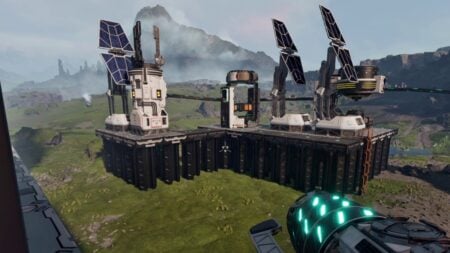Skip To...
Many years ago, Metroidvania games fell into a very similar visual style: Scary, dark areas with somewhat grotesque creatures that instilled fear. Added to that was brutal and aggressive combat that would make you dismember any poor enemy in front of you. Now, I’m glad to see that even though the new games keep the iconic gameplay of finding things to explore new areas, each new installment feels more iconic. With that in mind, Ultros is the most unique game of the genre I have played due to its style, exploration, and narrative.
Ultros Review

Ultros is advertised as a psychedelic Metroidvania, and true to its word, it is. From the visual style to the themes it handles and the characters you meet on the ship, everything is a colorful journey that offers moments of peace and introspection despite being a game of an established genre. It was an experience with a slow start, but the more I progressed, the more questions I had about what I was doing in the story. Is it correct that I’m killing every creature I encounter? Should I let them live? While I like that Metroidvanias make me think about how to explore, this entry made me question every action I took in my adventure, making it more memorable.
Story: Enter The Sarcophagus

Ultros puts you in the space boots of Ouji, our mysterious protagonist. After supposedly crashing into The Sarcophagus, our adventurer realizes she is in an endless loop. You see, this ship is home to Ultros, an evil entity that is being incubated here. The only way to break the loop or advance is to kill the seven Shamans who inhabit the ship. So far, it is a simple story: Find a weapon and eliminate the seven individuals on the space vessel, but things are more complex than they seem. Each new cycle made me realize that maybe I wasn’t doing the right thing. Maybe killing wasn’t ideal, and that shows thanks to the excellent contrast of creation and destruction that the narrative presents.
Speaking of contrast, there are always two concepts in front of you: create or destroy. And fortunately, it translates it to the gameplay in a phenomenal way. To advance the story, you always have two options: kill your enemies or find a peaceful solution. There is even the option to progress through the game without a weapon. When I had already killed my fifth Shaman, I discovered that part of the story prompted me to reconnect the Shamans on the ship and, guess what? When I restarted the cycle, I got a different cutscene. Instead of creepy scenes, it now looked a little more hopeful, so what was in store for me if I went down that path?

It is important to mention that the game has different endings, some very obvious. You can go down the path of destruction and kill everyone or create a space garden and connect it to bring life to The Sarcophagus. Which is better? I would tell, but that would spoil the surprise. Nevertheless, Ultros offers one of the most unique methods of storytelling I have ever seen, making the experience more than memorable. There was no need for dialogue decisions or a morality system. Instead, every action you perform changes the story you are living. This narrative is so organic that you never realize you are making decisions at every moment.
Gameplay: Bring Me to Life

Ultros is a Metroidvania with all the standard staples of the genre: a branching map with areas only accessible with new abilities, distinct enemies you’ll encounter in different locales, and fearsome bosses with unique mechanics. During your adventure, you’ll spot many typical Metroidvania-centric elements, but it’s clear that Ultros strives to make a distinct mark in the genre. Gameplay and design choices certainly work in its favor in some areas, but in others, not so much.
Let’s start with the exploration, which was the most entertaining part for me. The Sarcophagus is a ship with different areas ranging from classic sci-fi corridors to a forge full of dangerous machinery. What makes this different is the ability to grow plants. Part of the contrast I’m talking about is that aside from killing enemies, you can ignore this and make gardens on the ship. Aside from the pretty look of them, they’re fun to explore. Some seeds grow plants with vines to swing on, others make grass that lets you climb up walls, and some give you a platform to jump on. In all the games I’ve played, I’ve never seen such an organic exploration system (pun intended).

Furthermore, plants also help you in combat. Ultros has minimal but significant roguelite systems. Each plant that grows on the ship gives its fruits, and you can eat them to increase one of the four nutrient bars you have. You consume these bars to buy abilities such as adding hits in a combo or increasing your HP. Since cycles reset, your skills do, too, but some things mitigate the loss. Each skill costs less the second time you get them, and there are items that save skills so you don’t lose them, making each player character think of an ideal build for each cycle.
While making builds sounds interesting for combat, it wasn’t so much for me. Now, that’s not to say it’s a bad system. The game rewards you for performing different combos. Each enemy you defeat also gives you parts that provide you with nutrients, but the amount depends on how creative you are at killing. If you mash buttons, you’ll get some bad parts, but by combining combos, you can get perfect parts that give you more. And although this is somewhat original, I always felt that the game needed to be more challenging to make me create a specific build. Although, I can understand why.

Finally, I understand the lack of difficulty relies on the care put into exploration. At a certain point, I unlocked insects that opened secret areas and even allowed fast travel; that’s when I realized that combat was not so necessary to advance. Sure, you’ll need to cut branches and enemies if you want to see all the endings, but it doesn’t have to be that way. If you feel creative, there are many ways to avoid boss fights and reach the end. Ultimately, Ultros allows you to cultivate even your narrative, and it kept me engaged as I explored this colorful ship.
Graphics & Audio: A Kaleidoscopic Journey

Undoubtedly, Ultros has the most unique art I’ve seen in a while. After his work on Hotline Miami, Niklas “El Huervo” Åkerblad serves as creative and art director, giving an unparalleled vision to any installment of this genre. Each biome of the ship is an amalgam of colors that fits perfectly. All areas have an iconic color palette that makes them easy to remember. I could tell you that I had a favorite, but the truth is that I loved every single one of them. I’m glad to see that the days of dark environments are behind us, and now artists are trying something innovative in the genre.
Oscar “Ratvader” Rydelius is the soundtrack composer and does an excellent job. Throughout your adventure, you are accompanied by all the quiet tunes that go along with the mysticism that emanates from the art, and in the fights you decide to have, the music changes to something more moving and epic. Frankly, I have zero complaints on the audio/visual side of things. Every part fits together like a puzzle, making this a delight for any viewer.
Conclusion: To Prune or Not to Prune

Overall, Ultros is a unique work of art that keeps the genre’s iconic elements. While it nails many aspects, it still needs to polish some things. The exploration is entertaining but can become stressful in the last hours due to its complexity. The combat, which rewards precision and creativity, does not challenge the player too much. The story, which I loved for its contrasting themes, can be confusing for some who just want to fight and explore effortlessly. And, even so, I consider Ultros to be the most original Metroidvania I’ve played in years, and I hope it’s not the last time I see this world that the studio has so carefully created.
Ultros is available on PS4, PS5 (Reviewed), and PC.
Review copy given by Publisher.
Ultros (PlayStation 5 Reviewed)
A beautiful metroidvania with interesting exploration mechanics.
Pros
- One-of-a-kind art style.
- Interesting exploration mechanics.
- Deep lore with an engaging story.
Cons
- Combat isn't the game's biggest strength.
- The gameplay loop might not be for everyone.







